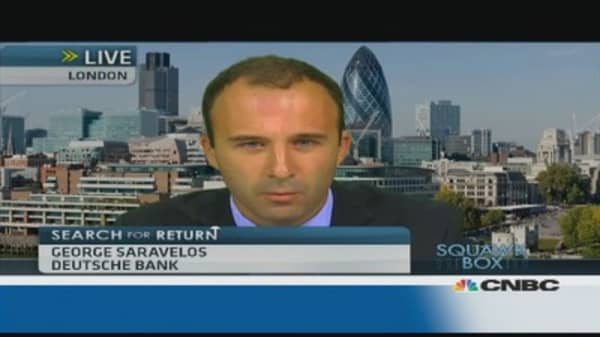Government bonds are the priciest assets in the world, with Japanese debt topping the overpriced league, according to a new report from Deutsche Bank.
Despite this year's global bond sell-off, the German bank found that bond yields were yet to return to 1997-2012 averages in any of the nine developed markets it analysed (the U.S., U.K., Canada, Germany, Sweden, Norway, Switzerland, Australia and Japan).
(View: Today's Treasury prices)
Deutsche said that U.S. Treasurys and U.K. Gilts were the closest to normalizing, but were still around 50 basis points below levels that prevailed pre-crisis. German bunds were roughly 70bp too expensive, while all other bond yields were still more than 100bps below fair value.
"We argue we are only about half-way through to more 'normal' yield levels, with plenty of potential for overshoot," said strategist George Saravelos in the report.
Markets have watched closely in recent weeks as yields on benchmark 10-year Treasurys edged near — and once hit in post-market trade — the psychologically 3 percent market.
(View: Bonds 101: Why 3% matters)
Saravelos said that fair value for Treasury yields was actually even higher, at 3.5 percent. Indeed, several banks have raised their long-term outlooks for Treasury rates over the past two months, with Barclays forecasting they will reach 3.75 percent by the third quarter of 2014.
"USTs (Treasury bonds) are about two-thirds of the way through in terms of risk premium normalization… Bond risk premia have been mean-reverting since 1997, when central banks first gained independence and cemented their inflation-fighting credibility," he said.
Outflows from U.S. bond mutual funds and ETFs accelerated in August according to TrimTabs, following outflows of $14.8 billion in July and $69.1 billion in June (a record high).
(Read more: Pimco: Media to blame for bond market exodus)
Deutsche noted that fixed income markets that lagged the global sell-off were most at risk of further weakness, and highlighted Canada, Australia, Sweden and Norway as examples.
"The over-valuation in these markets is in line with portfolio flow trends in recent years, which have seen a big rise in foreign ownership as a consequence of the global crisis," wrote Saravelos.
He named Japanese government bonds as the world's most overpriced assets however, citing high domestic ownership as the reason for their resilience hitherto to the global sell-off, coupled with the Bank of Japan's massive easing program.
Nonetheless, central banks hoping they can combat declining bond prices may be out of luck.
"We find that the vast bulk of this year's sell-off can be attributed to normalizing bond risk premia, rather than a change in central bank rate expectations. The implication is that there may be little central banks can do to fight this return to 'normality'," Saravelos said.
Wealth management firm Coutts seconded the bearish outlook for high-quality government bonds, but differed on the details. In a report out last month, it highlighted Treasurys as particularly vulnerable due to the wave of strong U.S. economic data, and forecast an underperformance versus cash over the next six months.
(Read more: The silver lining in the bond market panic selling)
Recent better-than-expected U.S. data have included business activity indicators for July and August, and a substantial decline in weekly unemployment claims last week. In addition, the unemployment rate dropped to 7.3 percent in August, although jobs growth proved weaker than had been hoped.
"We prefer to look elsewhere within fixed income, such as loans, high-yield bonds and selected emerging market bonds. We maintain our bias towards reducing duration (a measure of sensitivity to changes in interest rates), and believe careful selection is warranted within corporate bonds," Coutts said in its report.
—By CNBC's Katy Barnato





